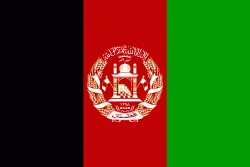Kandahar Province (Kandahār)
The province contains about 18 districts, over 1,000 villages, and approximately 1,431,876 people (the 6th most populous province), which is mostly tribal and a rural society. The main inhabitants of Kandahar province are the ethnic Pashtuns. They are followed by the Baloch people, Tajiks, Uzbeks, Turkmens and Hazaras.
There is speculation revolving around the origin of the name "Kandahar". It is believed to have started as one of many cities named after the Hellenistic conqueror Alexander the Great throughout his vast (mainly ex-Achaemenid) empire, its present form deriving from the Pashto rendering of Arabic Iskandariya = Ancient Alexandria (in Arachosia).
A temple to the deified Alexander as well as an inscription in Greek and Aramaic by the emperor Ashoka, who lived a few decades later, have been discovered in the old citadel.
Map - Kandahar Province (Kandahār)
Map
Country - Afghanistan
 |
 |
| Flag of Afghanistan | |
Human habitation in Afghanistan dates back to the Middle Paleolithic era, and the country's strategic location along the historic Silk Road has led it to being described, picturesquely, as the ‘roundabout of the ancient world’. Popularly referred to as the graveyard of empires, the land has historically been home to various peoples and has witnessed numerous military campaigns, including those by the Persians, Alexander the Great, the Maurya Empire, Arab Muslims, the Mongols, the British, the Soviet Union, and most recently by a US-led coalition. Afghanistan also served as the source from which the Greco-Bactrians and the Mughals, amongst others, rose to form major empires. The various conquests and periods in both the Iranian and Indian cultural spheres made the area a center for Zoroastrianism, Buddhism, Hinduism, and later Islam throughout history.
Currency / Language
| ISO | Currency | Symbol | Significant figures |
|---|---|---|---|
| AFN | Afghan afghani | Ø‹ | 2 |
| ISO | Language |
|---|---|
| PS | Pashto language |
| FA | Persian language |
| TK | Turkmen language |
| UZ | Uzbek language |















